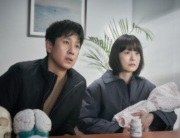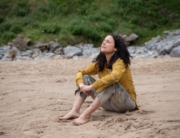In this true story of the Nazi occupation of Warsaw, a lovely and heroic Jessica Chastain is surrounded by a supportive international cast, and adorable animals. This gripping adaption of Diane Ackerman’s nonfiction bestseller honors Poles who risked death to help Jews and resist foreign domination.
Summer 1939: Antonina Zabinska (Chastain) happily wakes in a villa inside the Warsaw Zoo, where baby lynxes snuggle with her young son in bed. She bicycles around greeting animals large and small by name as if they, too, are her children, including an almost Disney-ish dromedary, before opening the gate to eager families. Her loving, ruggedly handsome husband, Jan (Johan Heldenbergh, of The Broken Circle Breakdown), is the zoo’s director, and he and his deputy, Jerzyk (Michael McElhatton, aka Roose Bolton on Game of Thrones), depend on her to help calm and care for their charges. She even helps deliver a baby elephant—only the 12th born up to that point in captivity.
Outside this oasis, Warsaw is nervous about Hitler’s intentions and the potential of war, while the couple is surprised by a visit from their Berlin Zoo colleague, Lutz Heck (Daniel Brühl). Impressed by their animal breeding successes, he’s all excited about making his unusual dream come true, to breed the European bison back to an atavistic breed of the extinct auroch.
September comes and the German message to Poland is now delivered directly by Luftwaffe bombs. The chaos of frantic beasts—leopards, monkeys, zebras, giraffes—also frightens trigger-nervous soldiers even as the zookeepers try to defend and calm the animals. Amid the carcasses and smoking ruins of the zoo’s nature habitats, Heck returns as the newly appointed chief zoologist for the Reich. He assures the couple he will help save their collection, by sending their best and rarest examples to Germany. While other films have revealed the Nazi plunder of art museums, this may be the first to depict the similar round-up of animals from zoos. Heck proudly announces that Hermann Göring, as the Reichsminister of Forestry, supports his plan for breeding legendary purebreds, in parallel to the Nazis’ goals for racially pure humans.
With their first priority to save their zoo, the shocked but gutsy zookeepers offer their bison and the facility for a breeding center. At Jan’s suggestion, Antonina adds a bit of flirtatious encouragement. Heck enthusiastically agrees when he returns in full Nazi officer regalia, and as a winter of hardships approaches, he shoots down their animals he deems not fit to survive. (In Ackerman’s retelling based on diaries and interviews, Heck actually led a SS New Year’s Eve “hunting party” through the grounds.)
By October 1940, Jews have to wear armbands and face more and more restrictions, causing wary Jewish friends to seek protection. First Maurycy Fraenkel (Iddo Goldberg) needs storage of his prized insect collection, then noted sculptor of animals Magda Gross (Efrat Dor) asks to hide in their house. (It’s clearer in the book that they were a couple.) Antonina assures Magda can stay, all the while soldiers patrol the ordnance stored on the zoo property.
As Jan watches the construction of the ghetto walls and the crowded resettlement within, he and Antonina resolve on a second priority: to save as many people as they can. He proposes another plan to Heck: let him and his wife use emptied plots for a pig farm that will provide meat for the German soldiers. The irony of the arrangement appeals to Heck. (Jan is able to sneak some slices to starving Jews abandoning dietary rules to stay alive.) The almost unbelievable-if-he-weren’t-true Jan works out a plan with the underground to help Jews and resistance fighters escape, by hiding them in the garbage truck and then in any empty space under and around his house and the zoo until they can be moved on to safe houses. Antonina works out rules for their “guests,” silence during the day, especially when their cook is in the house and the patrols are nearby. Her piano playing indicates warnings and the all-clear signal at night. Before sending them on, she helps dye their hair blonde so they can better fit in with the Polish population.
In her first urban-set film, director Niki Caro, along with cinematographer Andrij Parekh and production designer Suzie Davies, graphically bring to life (and death) the worsening conditions in the Warsaw Ghetto of 1943, almost matching the degradations seen in the footage Yael Hersonski discovered in A Film Unfinished (2010). Though the zoo was a way station for real-life rescuer Irena Sendler as she smuggled blonde children out of the ghetto, she is not represented here. Jan does try to help another well-known paragon of self-sacrifice, Dr. Janusz Korczak (Arnost Goldflam), but Jan’s offer for his escape is rebuffed. (Korczak was the subject of the 1990 Andrzej Wajda biopic.) There is also visual emphasis through fast-paced montages of the many brave Poles who aided the Zabinskis by providing secret exits and work passes and forged identity papers.
However, Angela Workman’s adaptation of the book descends into unnecessary Nazi stereotypes as Brühl has to ratchet up the exaggerated villainy to add to the tension. The Zabinskis well-deserved this exciting cinematic tribute and to be honored by Israel as “Righteous Among the Nations” for their real, heroic accomplishments in saving more than 300 people without the addition of fictional challenges.







Leave A Comment